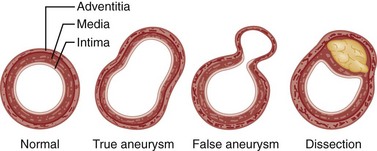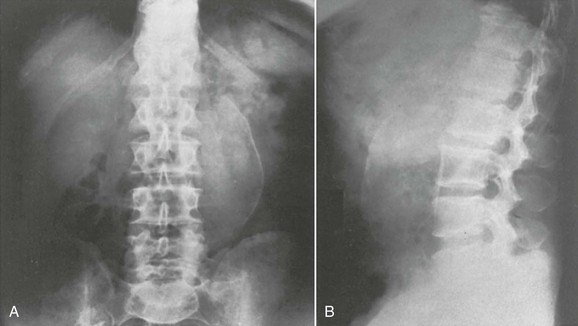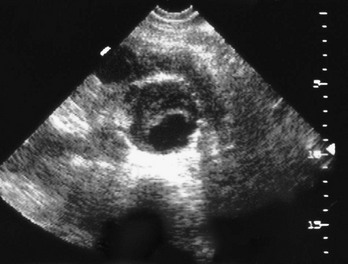Abdominal Aortic Aneurysm
Perspective
Abdominal aortic aneurysm (AAA) is a true aneurysm, meaning a localized dilation of the aorta caused by weakening of its wall, and involving all three layers (intima, media, and adventitia) of the arterial wall (Fig. 86-1). A false aneurysm, or pseudoaneurysm, is a collection of flowing blood that communicates with the arterial lumen but is not enclosed by the normal vessel wall; it is contained only by the adventitia or surrounding soft tissue. Pseudoaneurysms can arise from a defect in the arterial wall or a leaking anastomosis after AAA repair.
AAA is distinct from aortic dissection, which sometimes is incorrectly called a “dissecting aortic aneurysm.” In aortic dissection, blood enters the media of the aorta and splits (dissects) the aortic wall (see Chapter 85). Aortic aneurysm and aortic dissection are very different diseases, with different clinical presentations, complications, diagnostic methods, and treatments.
An aneurysm can develop in any segment of the aorta, but most involve the aorta below the renal arteries. The diameter of the normal adult infrarenal aorta is approximately 2 cm, and a diameter of 3 cm or more defines an AAA.1
Epidemiology
AAA is a disease of aging, and the prevalence of AAA is expected to increase as the population of elderly patients grows. AAA is rare before the age of 50 years but is found in 2 to 5% of men older than 50.2,3 The average age at the time of diagnosis is 65 to 70, and men are affected much more often than women. The patient often has concomitant atherosclerotic occlusive disease of the coronary, carotid, or peripheral vessels, which may influence the clinical presentations, complications, and management.
Several risk factors for the development of an AAA have been established, but risk factors are populational, not individual characteristics. An AAA can be found in 5 to 10% of elderly men who are screened with ultrasonography4,7 and in an even higher percentage of patients with coronary artery disease or peripheral vascular disease.4,6–8 The presence or absence of risk factors should not strongly influence diagnostic considerations in any individual patient (Table 86-1). A family history of an AAA is a very strong risk factor; those with an affected first-degree relative have a markedly increased risk of developing an AAA.9 Smoking is also a significant risk factor for AAA.10 Although awareness of high-risk groups can speed the recognition of AAAs, the consideration of AAA should not be restricted to patients in these groups. Recent data suggest that women may experience delays in diagnosis and worse operative mortality after ruptured AAA,11 and that up to half of AAAs in the United States occur in women, nonsmokers, and those younger than 65.12
Principles of Disease
AAAs have traditionally been attributed to atherosclerosis, but patients with advanced atherosclerosis have occlusive disease, not aneurysms. Recent data suggest that patients with AAA have biochemical abnormalities leading to the loss of elastin and collagen, the major structural components of the aortic wall.13 The propensity to form aneurysms may have a genetic basis, but the exact mode of inheritance is uncertain. The Society for Vascular Surgery recommends labeling the typical degenerative AAA as “nonspecific,” rather than “atherosclerotic,” to reflect this uncertainty surrounding the etiology.
Natural History
The most important factor determining the risk of rupture is the size of the aneurysm.14–17 The risk increases dramatically with increased aneurysm size, and most ruptured AAAs have diameters greater than 5 cm. The growth rate of the AAA, in addition to other anatomic factors, may also be important in determining the risk of rupture.18,19 Although rupture of aneurysms smaller than 4 cm is rare,16 no aneurysm is completely “safe.”3,20 Any aneurysm can rupture and cause the patient’s emergency department (ED) presentation.
Rupture of an AAA usually occurs into the retroperitoneum, where hemorrhage may be temporarily limited by clotting and tamponade at the rupture site, but 10 to 30% involve free intraperitoneal rupture, which is often rapidly fatal.21 Occasionally, rupture occurs into the gastrointestinal tract or the inferior vena cava.
Complications can also arise from an intact AAA. The walls of an AAA are often lined with clot and atheromatous material, which can embolize and occlude distal vessels.22 Aortic thrombosis may occur rarely. Patients can also have complications caused by impingement on adjacent structures.
In approximately 5% of AAAs, a dense inflammatory and fibrotic reaction develops in the aneurysm wall and adjacent retroperitoneal tissue. In these “inflammatory” AAAs, the periaortic fibrosis may incorporate and obstruct adjacent structures, such as the ureters or duodenum.23
Clinical Features
In most cases, an AAA is asymptomatic and is discovered incidentally on physical examination, on a radiologic study done for other reasons, or by an ultrasonography aneurysm screening program.1,24 Symptoms usually do not develop until the aneurysm ruptures.
Symptomatic aneurysms are usually fairly large and are often palpable. Likewise, the patient with an aneurysm large enough to warrant elective repair often has a palpable abdominal mass.25,26 However, an AAA may be difficult to palpate if the aneurysm is small or the patient is obese. Published reports indicate that 30 to 60% of unruptured aneurysms measuring 3.0 to 3.9 cm on ultrasonography can be detected by abdominal palpation; 50 to 70% of aneurysms measuring 4.0 to 4.9 cm and 75 to 85% of aneurysms 5 cm or larger can be palpated.25,26 These reports are based on the examination of patients with intact, asymptomatic aneurysms, with the examination specifically directed at sizing the aorta. The sensitivity is likely much lower when the abdomen is not palpated deeply, or in hypotensive patients or those with significant abdominal guarding. There is virtually no risk of causing aneurysm rupture by abdominal palpation.25
Physical examination may raise suspicion regarding an AAA even when the aorta is of normal size.25 A tortuous aorta may feel enlarged, and prominent aortic pulsations, especially in a thin patient, may simulate an aneurysm. Moreover, pulsations from a normal aorta may be transmitted to an adjacent abdominal mass. Nonetheless, clinical suspicion of AAA warrants further investigation.
An abdominal bruit is an uncommon finding in patients with AAAs. The presence of a bruit is also nonspecific, as bruits can originate in a stenotic renal, iliac, or mesenteric artery. A loud continuous bruit suggests the diagnosis of aortovenous fistula, a rare complication of AAAs.27
Thromboembolic complications can occur spontaneously or when atheromatous plaques are disrupted during invasive intravascular procedures. Large emboli can acutely occlude major vessels such as the iliac, femoral, or popliteal artery, causing acute painful lower extremity ischemia with absent distal pulses. Rarely, the aneurysm itself can thrombose, rendering both lower extremities acutely ischemic. More often, however, microemboli consisting of cholesterol crystals or clot obstruct small distal vessels, such as the digital arteries of the toes and arterioles and capillaries of the skin. These patients have livedo reticularis; one or more cool, painful, cyanotic toes; and palpable pedal pulses. This constellation of findings, often called the blue toe syndrome,28 is highly suggestive of a proximal source of emboli. When an AAA is the source, the aneurysm is often too small to palpate and may be discovered only after radiologic investigation.22,28
Rarely, an intact AAA causes symptoms by compressing adjacent structures, with symptoms depending on the structures involved. Large, long-standing aneurysms can cause vertebral body erosion and severe back pain. Compression of the duodenum between the superior mesenteric artery and an AAA can cause duodenal obstruction, vomiting, and weight loss.29 Obstruction of the ureters in the patient with an inflammatory aneurysm can cause symptoms suggestive of ureteral colic.23
Ruptured Aneurysms
The mechanism of the pain associated with aneurysm rupture is poorly understood. It may be caused by expansion of the aortic wall or by stimulation of sensory nerves in the retroperitoneum. Identical pain can occur with intact but acutely expanding aneurysms, which may be impossible to differentiate clinically from ruptured aneurysms.30,31 Acute pain in the patient with an AAA should be considered a symptom of rupture or impending rupture.
In patients with a ruptured aneurysm, the duration of symptoms before presentation varies greatly. Some patients are seen shortly after severe pain and hypotension develop. In others, rupture is initially contained in the retroperitoneum, blood loss is small, and the presentation is delayed. Rare patients with a ruptured AAA may have symptoms for several days or even weeks before seeking medical attention32; therefore a long duration of symptoms does not exclude the diagnosis of ruptured AAA.
Rupture of an AAA may be accompanied by nausea and vomiting, and sudden hemorrhage can cause syncope or near-syncope. Compensatory hemodynamic mechanisms may then return the blood pressure and cerebral perfusion to normal. Transient improvement in symptoms is common but will be followed by hemodynamic deterioration if diagnosis and treatment are delayed.33
Ruptured AAAs are often large, and most patients have palpable abdominal masses.34 As with intact aneurysms, a ruptured AAA may not be palpable if the aneurysm is small or the patient is obese. The examination may be difficult if abdominal guarding is present or if an ileus causes significant distention. Aortic pulsations may not be prominent if the blood pressure is low. When a mass is not palpable, the diagnosis may be delayed.
Hypotension is the least consistent part of the triad, occurring in approximately half of patients, and is often a late finding.33,34 When the initial blood loss is minor, vital signs are often normal. Patients with initially normal vital signs are more likely to be misdiagnosed33 and may quickly and unpredictably deteriorate and become hypotensive.
Occasionally, rupture into the retroperitoneum is sealed and contained for many weeks or months.32 When this occurs, patients develop abdominal or back pain, presumably at the time of aneurysm leakage, which subsequently diminishes or resolves completely. If the diagnosis is made, chronic rupture (organized hematoma) is found at surgery. These patients can have chronic pain and may progress to free rupture and massive hemorrhage at any time.32
Aortoenteric Fistula
An AAA can rupture into the gastrointestinal tract (aortoenteric fistula [AEF]) or inferior vena cava (aortocaval fistula). A primary AEF is formed when an unrepaired AAA erodes into the gastrointestinal tract,35 usually the third or fourth portion of the duodenum. A secondary AEF, a communication between the site of previous aortic surgery and the gastrointestinal tract,36,37 can occur as a late complication of AAA repair and should be considered as the leading diagnosis in any patient with a severe gastrointestinal bleed and a history of aortic graft placement.
The patient with an AEF may have abdominal or back pain, fever and other signs of intra-abdominal infection, or gastrointestinal bleeding. Because most of these fistulae are into the duodenum, hemorrhage usually manifests as hematemesis or melena. The initial bleeding results from erosion of vessels in the bowel wall and is often minor.37 Later, often after several days to a week or longer, massive bleeding results from rupture into the intestinal lumen.
Aortovenous (Aortocaval) Fistula
An aortovenous (usually aortocaval) fistula arises when periaortic inflammation causes adherence of the aorta to an adjacent vein, with pressure on the vessel walls causing the development of an arteriovenous communication. If concomitant extravasation of blood into the retroperitoneum occurs, the clinical presentation is similar to that of other patients with ruptured AAAs, often with hypovolemic shock. More commonly, however, the aneurysm ruptures into the vena cava without leaking externally, and the signs and symptoms of a large arteriovenous fistula dominate the clinical picture.27,38
As in other patients with AAAs, a patient with an aortovenous fistula may have abdominal or back pain. An aneurysm that becomes fistulous with the vena cava is usually large, and 80 to 90% are palpable. A continuous abdominal bruit can be auscultated in approximately 75% of patients with aortovenous fistulae, and 25% of patients have a palpable abdominal thrill.38
Shunting of blood from the arterial to the venous system increases venous pressure, venous volume, and venous return to the heart. Signs and symptoms of high-output congestive heart failure (dyspnea, jugular venous distention, pulmonary edema) are often present.38 The increased venous volume and pressure can cause lower extremity edema or cyanosis, and dilated superficial veins can be seen on the legs or abdominal wall. Distention and rupture of veins in the bladder mucosa can cause gross or microscopic hematuria; rectal bleeding can occur for similar reasons. Because of shunting of arterial blood into the venous system, the lower extremities may be cool with diminished pulses.
The patient with an aortovenous fistula often has renal insufficiency caused by a decrease in renal perfusion as a result of high-output congestive heart failure and increased renal venous pressure. Such patients may exhibit hematuria, which is common when an aortovenous fistula is present but not in other patients with AAAs.38 Computed tomography (CT; preferably CT angiography) can rule out aortovenous fistula formation.
Diagnostic Strategies
Plain film radiography is not indicated in the evaluation of a patient for suspected AAA. A normal plain abdominal radiograph does not exclude the presence of an AAA and rarely identifies alternative pathology. Even if an aneurysm is identified on plain film because it is calcified, imaging with CT is required to identify whether the aneurysm is an incidental or culprit lesion in the patient’s presentation (Fig. 86-2).
Ultrasonography
Ultrasonography is virtually 100% sensitive in detecting AAAs (Fig. 86-3), when a technically adequate study can be obtained.1 Measurements of aortic diameter are very accurate and reproducible. Because it is relatively inexpensive and requires no contrast agents or radiation exposure, ultrasonography is used for nonemergency aneurysm diagnosis and to follow patients with known aneurysms.
Ultrasonography has distinct advantages in the emergency evaluation of a patient with a suspected ruptured AAA.39 It can be performed very rapidly at the patient’s bedside, obviating the need to take a potentially unstable patient to the radiology suite. If an aorta with a normal diameter throughout its abdominal course is visualized, the patient does not have an AAA. In addition, ultrasonography sometimes provides alternative explanations for the patient’s pain by revealing other conditions, such as acute cholecystitis.








